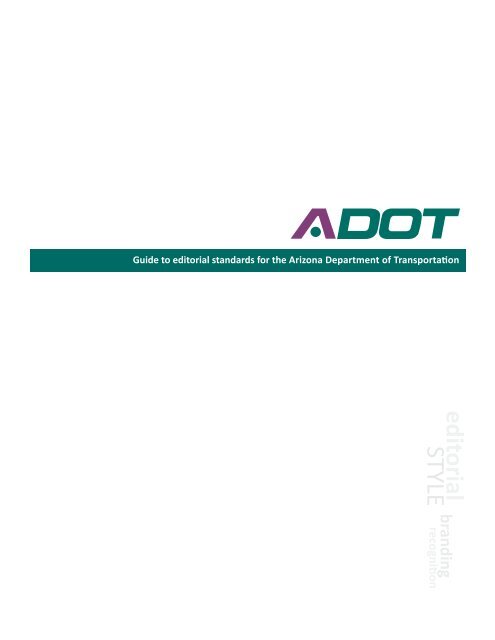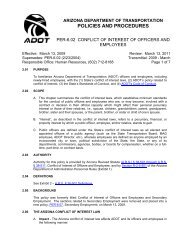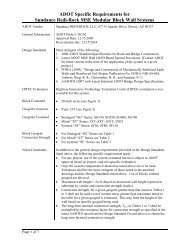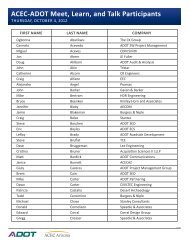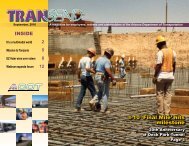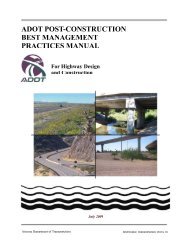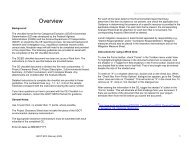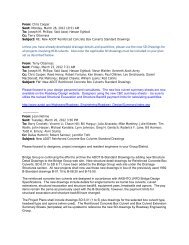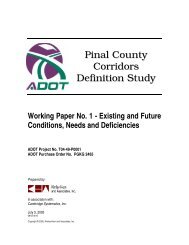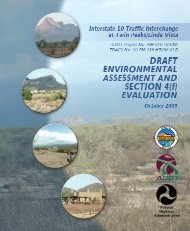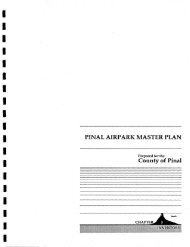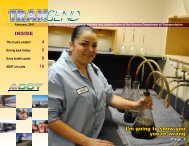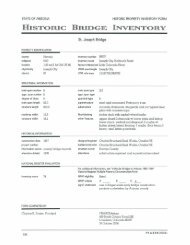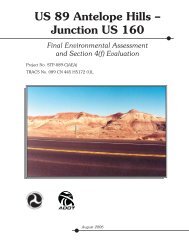ADOT Editorial Style Guide - Arizona Department of Transportation
ADOT Editorial Style Guide - Arizona Department of Transportation
ADOT Editorial Style Guide - Arizona Department of Transportation
You also want an ePaper? Increase the reach of your titles
YUMPU automatically turns print PDFs into web optimized ePapers that Google loves.
<strong>Guide</strong> to editorial standards for the <strong>Arizona</strong> <strong>Department</strong> <strong>of</strong> <strong>Transportation</strong><br />
editorial<br />
STYLE branding<br />
recognition
Our Mission<br />
• To provide a safe, efficient, cost-effective transportation system.<br />
Our Vision<br />
• The standard <strong>of</strong> excellence for transportation systems and services.<br />
Our Goals<br />
• Maximize available resources to provide essential services to <strong>ADOT</strong>’s customers.<br />
• Identify and explain the need for new, sustainable funding opportunities dedicated to multimodal<br />
transportation projects.<br />
Our Strategies<br />
• Prioritize and focus on the products and services most critical to serving the public, collecting<br />
revenue, and maintaining the transportation infrastructure.<br />
• Align the organizational structure to optimize effectiveness and reduce costs.<br />
• Increase efficiency <strong>of</strong> service delivery processes and systems.<br />
• Refine <strong>ADOT</strong>’s performance measures.<br />
• Research, evaluate, and explain alternative funding sources to help finance and maintain a<br />
multimodal transportation system.<br />
Questions regarding this guide or its contents?<br />
Please contact <strong>ADOT</strong> Communications<br />
Graphics Supervisor<br />
1655 W Jackson St.<br />
MD 126F, Room 170<br />
Phoenix, <strong>Arizona</strong> 85007<br />
graphics@azdot.gov<br />
602.396.0681<br />
Revised Jan. 2, 2013<br />
<strong>Guide</strong> to editorial standards
<strong>Editorial</strong> <strong>Style</strong> <strong>Guide</strong><br />
........................................................................................... 1. Introduction to the <strong>Editorial</strong> <strong>Style</strong> <strong>Guide</strong><br />
........................................................................................... 2. Technical Considerations<br />
........................................................................................... 3. <strong>Editorial</strong> <strong>Style</strong><br />
........................................................................................... 4. Punctuation Review<br />
........................................................................................... 5. Appendix: Research Center <strong>Style</strong>
1. <strong>Editorial</strong> <strong>Style</strong> <strong>Guide</strong> | Introduction<br />
<strong>ADOT</strong>’s editorial style guide is a living document and may be amended based on necessity. If you would like to see an alteration made to<br />
the style guide, please submit a written request, which should include a justification and source(s) for the alteration, to Danelle Weber<br />
(DMallen@azdot.gov) between Jan. 15 and Dec. 15 every year. Please note that submitting a request does not guarantee the desired<br />
alteration will be approved. If an alteration is approved, it will be added to the style guide and released for general consumption on or<br />
before Jan. 15 every year.<br />
The following guidelines delineate editorial style policies that apply to the entire <strong>Arizona</strong> <strong>Department</strong> <strong>of</strong> <strong>Transportation</strong>. The main<br />
sources for this style guide are the 2011 Associated Press <strong>Style</strong>book, the <strong>Style</strong> Manual for AASHTO Publications and the Merriam-<br />
Webster dictionary. Refer to these sources if a language question is not answered here. <strong>Style</strong> guide entries are arranged alphabetically.<br />
The formatting is explained below.<br />
Example Entry<br />
dates. Always use Arabic figures with st, nd, rd or th. Do not superscript ordinals: 5th <strong>of</strong> November. Abbreviate these months: Jan.,<br />
Feb., Aug., Sept., Oct., Nov. and Dec.<br />
GENERAL FORMATTING. Month Day, Year: Jan. 15, 1949. Month Day: Jan. 15. Month Year: January 1949. Do not include ordinal<br />
indicators when the day comes after the month.<br />
Explanation<br />
Bold Calibri type indicates correct capitalization, italicization, abbreviation and punctuation <strong>of</strong> entries.<br />
Cambria type shows examples <strong>of</strong> correct and incorrect usage.<br />
BOLD, CAPS CALIBRI type indicates a subheading under a main entry.<br />
Entries are arranged alphabetically. If you would like to visit a specific entry, search the document by pressing CTRL + F and entering an<br />
appropriate search term.<br />
<strong>ADOT</strong> <strong>Guide</strong> to editorial standards
2. <strong>Editorial</strong> <strong>Style</strong> <strong>Guide</strong> | Technical Considerations<br />
You will probably come across some common considerations and program limitations while creating documents for <strong>ADOT</strong>. This section<br />
gives instructions for properly formatting ellipses, em dashes and subscripts as well as avoiding widows and orphans.<br />
Ellipses, ...<br />
Micros<strong>of</strong>t Office’s default setting auto-formats ellipses incorrectly, with no spaces before or after the periods: dog…walked. To type<br />
correctly formatted ellipses, this setting needs to be changed. You can either delete the auto-format feature for ellipses to enable typing<br />
them manually or program Office to auto-format them correctly. (Note: There is no way to auto-format a four-point ellipsis [a period<br />
plus an ellipsis]. For four-point ellipses, manually type four periods and the appropriate spaces.)<br />
Here’s how to change ellipsis auto-formatting in Micros<strong>of</strong>t Office 2010:<br />
1. Click the File tab in the upper left-hand corner.<br />
2. Click Options.<br />
3. Click Pro<strong>of</strong>ing.<br />
4. Click AutoCorrect Options.<br />
5. Click the AutoCorrect tab.<br />
6. Highlight the ellipsis row beneath “Replace text as you type.” If no ellipsis is present, there is currently no default setting. To add<br />
the correct auto-formatting, type three periods [...] in the box under “Replace:” and follow the instructions below.<br />
7. To delete, press the Delete button, and click OK.<br />
8. To add or correct the default setting, place the cursor in the box below With.<br />
a. Type “ ... ” ([space][period]period][period][space]).<br />
b. Click OK.<br />
Em Dashes, —<br />
There are two ways to create em dashes<br />
• Type two hyphens between words without using spaces to create an em dash after the second word and a space are typed (you’ll<br />
have to add the spaces manually).<br />
• Use the em dash keyboard shortcut, which is CTRL + ALT + MINUS SIGN. This shortcut only works with the minus sign on the<br />
number pad to the right <strong>of</strong> the keyboard.<br />
Subscripts and Superscripts<br />
To add or delete subscripts, click the Home tab and click the arrow on the lower right-hand corner <strong>of</strong> the Font group to see the Font<br />
box. Under Effects, click the box next to Subscript and click OK. Do not superscript font.<br />
Widows and Orphans<br />
Widow: The last line <strong>of</strong> a paragraph at the top <strong>of</strong> a page or column.<br />
Orphan: The first line <strong>of</strong> a paragraph at the bottom <strong>of</strong> a page or column; also a word, a part <strong>of</strong> a word or very short line (four characters<br />
or fewer) that appears by itself at the end <strong>of</strong> a paragraph.<br />
Avoid widows and orphans; they can create too much white space and negatively affect readability. Whenever possible, reformat the<br />
text or revise the paragraph (e.g., enter s<strong>of</strong>t returns or manual page breaks). It is preferable to have extra white space at the bottom <strong>of</strong><br />
a page than to have one paragraph-ending line at the top <strong>of</strong> a page.<strong>Editorial</strong> <strong>Style</strong><br />
<strong>ADOT</strong> <strong>Guide</strong> to editorial standards
3. <strong>Editorial</strong> <strong>Style</strong> <strong>Guide</strong> | <strong>Editorial</strong> <strong>Style</strong><br />
A<br />
a, an. Use the article a before consonant sounds: a historic event, a one-year term, a united stand. Use the article an before vowel<br />
sounds: an energy crisis, an honorable person, an NBA record, an 1890s celebration.<br />
abbreviations. Most two-letter abbreviations will take periods.<br />
BEFORE A NAME. Abbreviate titles when used before a full name: Dr., Gov., Ms., Sen.<br />
AFTER A NAME. Abbreviate junior and senior after an individual’s name, setting it apart with commas: John Jacob, Jr., is old. Abbreviate<br />
company, corporation, incorporated and limited when used after the name <strong>of</strong> a corporate entity. In some cases, an academic degree<br />
may be abbreviated after an individual’s name: House, M.D.<br />
FIRST AND SECOND REFERENCE. Most names should not be abbreviated on the first reference. Refer to the 2011 AP <strong>Style</strong>book for<br />
specific instances.<br />
WITH DATES OR NUMERALS. Use A.D. (A.D. 2012), B.C. (567 B.C.), a.m. (7:30 a.m.), p.m. (7 p.m.) and No. (No. 2). Abbreviate these<br />
months: Jan., Feb., Aug., Sept., Oct., Nov. and Dec. Spell out all other months. Spell out all months appearing alone or with a year<br />
alone. Do not separate the month and the year with a comma: January 1972 was a cold month.<br />
INITIALS. Separate partial initials with periods and no space: W.C. Fields.<br />
STATES. Spell out state names when they stand alone in textual material. These states are always spelled out, regardless <strong>of</strong> context:<br />
Alaska, Hawaii, Idaho, Iowa, Maine, Ohio, Texas and Utah. When in conjunction with a city name in text and datelines, and in shortform<br />
party affiliation, use these abbreviations (postal codes in parentheses for clarity): Ala. (AL), Ariz. (AZ), Ark. (AR), Calif. (CA), Colo.<br />
(CO), Conn. (CT), Del. (DE), Fla. (FL), Ga. (GA), Ill. (IL), Ind. (IN), Kan. (KS), Ky. (KY), La. (LA), Md. (MD), Mass. (MA), Mich. (MI), Minn.<br />
(MN), Miss. (MS), Mo. (MO), Mont. (MT), Neb. (NE), Nev. (NV), N.H. (NH), N.J. (NJ), N.M. (NM), N.Y. (NY), N.C. (NC), N.D. (ND), Okla. (OK),<br />
Ore. (OR), Pa. (PA), R.I. (RI), S.C. (SC), S.D. (SD), Tenn. (TN), Vt. (VT), Va. (VA), Wash. (WA), W.Va. (WV), Wis. (WI) and Wyo. (WY).<br />
YEARS. Use figures without commas: 1912. When a phrase refers to a month, day and year, set <strong>of</strong>f the year with a comma: February<br />
14, 1912, was the first day <strong>of</strong> <strong>Arizona</strong>’s statehood. Use an s without an apostrophe to indicate spans <strong>of</strong> decades or centuries: the<br />
1960s, the 1900s. Years are the lone exception to the general rule in numerals that a figure is not used to start a sentence. Use an<br />
apostrophe to show omitted numerals in a year: ’60s, ’75.<br />
academic degrees. Use an apostrophe and an s for general degrees: bachelor’s degree, master’s degree. (Exception: associate<br />
degree.) Do not use a possessive for full degree names: Bachelor <strong>of</strong> Arts, Master <strong>of</strong> Science. When used after a name, an academic<br />
abbreviation is set <strong>of</strong>f by commas: Jane Smith, Ph.D., spoke; John Doe, M.A. Curriculum, wrote.<br />
acronyms. Most acronyms, especially those that are longer than two letters, will not take periods. Check the 2011 AP <strong>Style</strong>book for<br />
specific instances.<br />
A.D. Use instead <strong>of</strong> C.E. Include the periods.<br />
addresses. Capitalize and use these abbreviations only with numbered addresses: Ave., Blvd., Dr., Ln., Pkwy., Rd. and St. Spell out<br />
these abbreviations and capitalize when part <strong>of</strong> a formal street name without a number: Pennsylvania Avenue. Never abbreviate<br />
these street designations, but capitalize them with numbered addresses and formal street names without numbers: alley, circle,<br />
highway, route, way and terrace. Spell out and lowercase street designations when used alone or with more than one street name:<br />
Massachusetts and Pennsylvania avenues. Abbreviate compass points used to indicate directions or quadrants <strong>of</strong> a city in a numbered<br />
address: 1655 W. Jackson St. No periods for quadrant abbreviations: NW, SE. Do not abbreviate if the number is omitted: West<br />
Jackson Street. Do not use the periods for any abbreviations in maps and graphics.<br />
<strong>ADOT</strong> CONTACTS, IN-LINE. Title Name, Phone number. District Engineer Josefina Mendez, 602.555.1009.<br />
<strong>ADOT</strong> CONTACTS, VERTICAL. Name [s<strong>of</strong>t return] Title [s<strong>of</strong>t return] Street address [s<strong>of</strong>t return] Mail Drop/Suite/Room [s<strong>of</strong>t return] City,<br />
State ZIP code [s<strong>of</strong>t return] Phone: Number [s<strong>of</strong>t return] Fax: Number. Online, names should be hyperlinked to that person’s email<br />
address. Only include the information that is available or pertinent.<br />
Josefina Mendez<br />
District Engineer<br />
1655 W. Jackson St.<br />
MD 305<br />
Phoenix, AZ 85007<br />
Phone: 602.555.1009<br />
Fax: 602.555.1010<br />
<strong>ADOT</strong> <strong>Guide</strong> to editorial standards
3. <strong>Editorial</strong> <strong>Style</strong> <strong>Guide</strong> | <strong>Editorial</strong> <strong>Style</strong><br />
HIGHWAYS and FREEWAYS. Highway and freeway abbreviations should have no periods: US 60, SR 51. Hyphenate interstate<br />
abbreviations: I-10, I-17. Capitalize specific highway names when spelled out; no hyphen is necessary: U.S. Route 60, Interstate 17.<br />
Do not abbreviate loop: Loop 202. For exits that have a lettered designation and for highway and freeway designations that include a<br />
direction, place the capital letter on the right <strong>of</strong> the last numeral with no space between or period after: Exit 13A, I-10E.<br />
ZIP CODES. Do not include the four-digit extension.<br />
Adopt a Highway program. Preferred capitalization.<br />
adviser. Not advisor.<br />
affect, effect. Affect is the verb; effect is usually the noun.<br />
African-American, black. Acceptable for an American black person <strong>of</strong> African descent. The terms are not necessarily interchangeable.<br />
People from Caribbean nations, for example, generally refer to themselves as Caribbean-American. Follow a person’s preference.<br />
afterward. Not afterwards.<br />
age. Always use figures: You must be 16 to earn a driver license. Use hyphens for ages expressed as adjectives before a noun or as<br />
substitutes for a noun: a 5-year-old boy and a 5-year-old, but the boy is 5 years old.<br />
air entraining (n.), air-entraining (adj.). Preferred constructions.<br />
air hole. Two words.<br />
al-[Name]. For Arabic names with the article “al,” lowercase the article and connect it to the name with a hyphen.<br />
all right. Not alright.<br />
alloy steel (n.), alloy-steel (adj.). Preferred constructions.<br />
alphabetization. Use the word-by-word system for alphabetizing lists. Take spaces and hyphens into account.<br />
AM, FM. The radio broadcast frequencies; no periods.<br />
ambient temperature (n.), ambient-temperature (adj.). Preferred constructions.<br />
amendment, Amendment. General amendments are lowercase; capitalize in reference to specific amendments to the U.S. Constitution:<br />
First Amendment, 10th Amendment.<br />
American. An acceptable description for a citizen <strong>of</strong> the United States. Avoid where use is not necessary to context and where<br />
citizenship is not a universally common factor in the population being referenced or the audience consuming the message.<br />
American Indian, Native American, Indian. American Indian is preferred, but Native American is still acceptable. Where possible, be<br />
more specific: Navajo commissioner. When known, defer to an individual’s preference. Do not use Indian to refer to American Indians.<br />
among, between. Most <strong>of</strong> the time, between introduces a relationship between two items, and among introduces the relationship<br />
among three or more items. However, between is also correct when expressing the relationships <strong>of</strong> three or more items considered<br />
one pair at a time: Negotiation on a debate format are under way between the network and the Ford, Carter and McCarthy<br />
committees.<br />
as well as. Does not mean and.<br />
at grade (n.), at-grade (adj.). Preferred constructions.<br />
ax. Not axe.<br />
<strong>ADOT</strong> <strong>Guide</strong> to editorial standards
3. <strong>Editorial</strong> <strong>Style</strong> <strong>Guide</strong> | <strong>Editorial</strong> <strong>Style</strong><br />
B<br />
backfill. One word.<br />
backward. Not backwards.<br />
bankfull. One word.<br />
B.C. Use instead <strong>of</strong> B.C.E. Include the periods.<br />
because, since. Use because to denote a specific causal relationship: The ro<strong>of</strong> is rotting because there is a leak. Since is only<br />
acceptable in a causal sense when the first event in a sequence led logically to the second but was not its direct cause: They went to<br />
the game since they had been given tickets.<br />
bedbug. Preferred spelling.<br />
bevel (n., v.), beveled (adj.). Preferred constructions.<br />
bidirectional. One word.<br />
black, African-American. Acceptable for an American black person <strong>of</strong> African descent. The terms are not necessarily interchangeable.<br />
Lowercase black in reference to the race.<br />
BlackBerry, BlackBerrys. Trademarked spelling: The BlackBerrys shipped slowly.<br />
bloc, block. A bloc refers to a coalition <strong>of</strong> people, groups or nations with the same purpose or goal; block does not.<br />
bolthead. One word.<br />
bolthole. One word.<br />
bolt tension (n.), bolt-tension (adj.). Preferred constructions.<br />
bull’s-eye. Preferred construction.<br />
bus, buses. Preferred plural spelling.<br />
bushhammer. One word.<br />
C<br />
cactus, cacti. Preferred plural spelling.<br />
cancel, canceled, canceling, cancellation. Preferred spellings.<br />
capital, capitol. Capitol only ever refers to the building where a legislative body meets.<br />
capitalization. Capitalize proper nouns: John, Capitol Hill, General Electric. Capitalize common nouns like party, river, street and<br />
west when they are an integral part <strong>of</strong> the full name for a person, place or thing: Republican Party, Colorado River, Central Avenue.<br />
Lowercase these common nouns when they stand alone in subsequent references: the party, the river, the avenue. Lowercase these<br />
common noun elements <strong>of</strong> names in plural uses: the Democratic and Republican parties, Main and State streets, lakes Erie and<br />
Ontario. Exception: plurals <strong>of</strong> formal titles with full names are capitalized: Presidents Franklin D. Roosevelt and Harry S. Truman.<br />
COMPOSITION TITLES. Capitalize the principal words, including prepositions and conjunctions <strong>of</strong> four or more letters. Capitalize articles<br />
(i.e., the, a, an) or words <strong>of</strong> fewer than four letters if it is the first or last word in a title or subtitle: “The Hunger Games,” “Harry Potter<br />
and the Sorcerer’s Stone.”<br />
PERSONAL TITLES. Capitalize formal titles when used immediately before a name. Lowercase formal titles when used alone or in<br />
constructions that set them <strong>of</strong>f from a name by commas. Use lowercase at all times for terms that are job descriptions rather than<br />
formal titles.<br />
<strong>ADOT</strong> <strong>Guide</strong> to editorial standards
3. <strong>Editorial</strong> <strong>Style</strong> <strong>Guide</strong> | <strong>Editorial</strong> <strong>Style</strong><br />
cause and effect (n.), cause-and-effect (adj.). Preferred construction: the cause and effect <strong>of</strong> the argument; a cause-and-effect<br />
relationship.<br />
celestial bodies. Capitalize the proper names <strong>of</strong> planets, stars, constellations, etc.: Mars, Arcturus, Earth. See entries for earth, sun and<br />
moon for more information.<br />
centerbeam. One word.<br />
Chicano, Hispanic, Latino, Mexican-American. These terms have distinct meanings that can vary depending on individual<br />
preferences. When possible, use a more specific identifier like Puerto Rican, El Salvadoran or Mexican-American. Avoid using Chicano<br />
interchangeably with Mexican-American. The use <strong>of</strong> Chicano, Hispanic and Latino should be consistent.<br />
child care. Two words.<br />
city, state. Separate the city and state name with a comma, and follow the state name with a comma unless ending a sentence:<br />
Phoenix, <strong>Arizona</strong>, is quite warm in the summer. Do not capitalize state or city in state/city <strong>of</strong> constructions: The city <strong>of</strong> Tempe is<br />
debating the issue. Do not capitalize state as an adjective to specify a level <strong>of</strong> jurisdiction: the state <strong>Transportation</strong> <strong>Department</strong>; state<br />
Rep. Jane Doe.<br />
clean up (v.), cleanup (n., adj.). Preferred constructions. We cleaned up the park. The cleanup crew was an hour early.<br />
c<strong>of</strong>ferdam. One word.<br />
cold-draw (v.). Hyphenate.<br />
cold-finish (v.). Hyphenate.<br />
cold flow (n.). Two words.<br />
cold-forge (v.). Hyphenate.<br />
cold-form (v.). Hyphenate.<br />
cold-roll (v.). Hyphenate.<br />
cold-swage (v.). Hyphenate.<br />
cold weather (n.), cold-weather (adj.). Preferred constructions.<br />
collective nouns. Singular collective nouns take singular verbs: The flock <strong>of</strong> geese is noisy. Plural collective nouns take plural verbs:<br />
The classes are settling their rivalry with a game <strong>of</strong> Jeopardy.<br />
common names. Lowercase common names <strong>of</strong> plants and animals: monarch butterfly, basset hound. Capitalize names derived from<br />
proper nouns and adjectives: English bulldog, Boston terrier.<br />
company and product names. On fist reference, precede the name <strong>of</strong> a product with the company name, but do not include the<br />
company name in subsequent uses. In general, follow the spelling and capitalization preferred by the company: eBay, YouTube.<br />
However, do not capitalize all the letters unless each letter is pronounced individually: BMW is okay; Ikea, not IKEA. Also, do not use<br />
symbols such as exclamation points, plus signs or asterisks that form contrived spellings that might confuse readers: Yahoo, not Yahoo!;<br />
Toys R Us, not Toys “R” Us; E-Trade, not E*Trade. Do not use a comma before Inc. or Ltd., even if it is included in the formal name.<br />
compass points. For references to compass points, follow these guidelines.<br />
ADDRESSES. Capitalize and abbreviate in a specific address: 42 N. Roosevelt. Capitalize and spell out when the address does not<br />
include a number: North Roosevelt.<br />
DIRECTIONS. Lowercase when the meaning <strong>of</strong> the direction is general: Drive north until you reach SR 87.<br />
<strong>ADOT</strong> <strong>Guide</strong> to editorial standards
3. <strong>Editorial</strong> <strong>Style</strong> <strong>Guide</strong> | <strong>Editorial</strong> <strong>Style</strong><br />
REGIONS. Capitalize when the meaning is specific and the region is defined by common culture, language or people: The Southwest<br />
has wonderful weather.<br />
complement, compliment. A complement completes something else. A compliment is an expression <strong>of</strong> praise.<br />
constant amplitude (n.), constant-amplitude (adj.). Preferred constructions.<br />
constitution, Constitution. Lowercase for general use and in reference to a state constitution without using the full, proper title.<br />
Capitalize when referring to the U.S. Constitution or the <strong>Arizona</strong> State Constitution.<br />
coplanar. No hyphen.<br />
copper alloy (n.), copper-alloy (adj.). Preferred constructions.<br />
council, counsel. A council is a group <strong>of</strong> leaders. To counsel is to advise.<br />
Council <strong>of</strong> Governments, COG. Preferred capitalization.<br />
countersink (n., v.). No hyphen.<br />
county. Capitalize when an integral part <strong>of</strong> a proper name: Maricopa County. Lowercase in county <strong>of</strong> phrases: county <strong>of</strong> Pinal.<br />
coworker. Preferred spelling.<br />
cross section (n.), cross-section (v.), cross-sectional (adj.). Preferred constructions.<br />
currency. Use $ to report U.S. dollar amounts and € for euros. For all other currencies, following the amount, spell out the name <strong>of</strong><br />
the currency followed in parentheses by the equivalent in U.S. dollars: Japan approved a 1.8 trillion yen ($18 billion) extra budget<br />
to partially finance an economic stimulus package. When dealing with a dollar currency <strong>of</strong> a country other than the United States,<br />
reference the 2011 AP <strong>Style</strong>book for the proper abbreviations and format.<br />
cut <strong>of</strong>f (v.), cut<strong>of</strong>f (n., adj.). Preferred constructions.<br />
czar. Use instead <strong>of</strong> tsar.<br />
D<br />
data. A plural noun that requires a plural verb: The data show a clear correlation.<br />
dates. Always use Arabic figures with st, nd, rd or th. Do not superscript ordinals: 5th <strong>of</strong> November. Abbreviate these months: Jan.,<br />
Feb., Aug., Sept., Oct., Nov. and Dec.<br />
GENERAL FORMATTING. Month Day, Year: Jan. 15, 1949. Month Day: Jan. 15. Month Year: January 1949. Do not include ordinal<br />
indicators when the day comes after the month.<br />
A.D./B.C. Do not use B.C.E./C.E. A.D. goes before the date; B.C. goes after the date: A.D. 1290; 500 B.C. All dates not designated B.C.<br />
are assumed to be A.D.<br />
TRAFFIC ALERTS. Two lines. First line: Direction, roadway, type <strong>of</strong> restriction (closed, restricted), location (between Point A and Point B),<br />
times and dates, reason. Second line: Detour:. Example: Northbound Interstate 17 closed between Lee Road and Hall Street from 10<br />
p.m. Friday, Feb. 17 to 5 a.m. Monday, Feb. 20 for pavement repair. Detour: Exit Lee Road to northbound President Street and have<br />
a good time.<br />
daylight saving time. Not savings.<br />
day care. Two words.<br />
dead load (n.), dead-load (adj.). Preferred constructions.<br />
deaf. Avoid where total loss <strong>of</strong> hearing is not present. Hard <strong>of</strong> hearing is the better term in these situations.<br />
<strong>ADOT</strong> <strong>Guide</strong> to editorial standards
3. <strong>Editorial</strong> <strong>Style</strong> <strong>Guide</strong> | <strong>Editorial</strong> <strong>Style</strong><br />
deaf and dumb, deaf-mute. Do not use.<br />
debond. One word.<br />
decision making (n.), decision-making (adj.). Preferred constructions: Decision making can be fun. The decision-making process is<br />
simple.<br />
deice, deicing. One word.<br />
delaminate. One word.<br />
desilverize. One word.<br />
detensioning. One word.<br />
descendant. Preferred spelling as both a noun and an adjective.<br />
despite, in spite <strong>of</strong>. They mean the same thing. Prefer former.<br />
different from. Not different than.<br />
disabled, handicapped, impaired. In general, do not describe an individual as disabled or handicapped unless it’s pertinent to the<br />
story. If a description must be used, try to be specific. Avoid descriptions that connote pity, such as afflicted with or suffers from. Words<br />
to avoid: cripple, handicap, deaf and dumb, deaf-mute, mentally retarded. Words to use with caution: disabled, blind (for total loss <strong>of</strong><br />
sight only; visually impaired elsewhere), deaf (for total loss <strong>of</strong> hearing only; partially deaf or partial hearing loss elsewhere) and mute<br />
(for physical inability to speak only; speech impaired elsewhere). Use wheelchair user for people who use wheelchairs for independent<br />
mobility. Do not use confined to a wheelchair or wheelchair-bound.<br />
disc, disk. Use disc for phonographic records and related terms (disc jockey), optical and laser-based devices (Blu-ray Disc) and for disc<br />
brake. Use disk for computer-related references and medical references, such as a slipped disk.<br />
discernible. Preferred spelling.<br />
document. Use this term to refer to files created in Micros<strong>of</strong>t Office Word only, not Excel or PowerPoint.<br />
do’s and don’ts. Preferred construction.<br />
double-click. Hyphenate.<br />
double-ply. Hyphenate.<br />
driver license. Preferred construction.<br />
dust storm. Preferred construction.<br />
E<br />
earth, Earth. Generally lowercase. Capitalize when used as the proper name <strong>of</strong> the planet. The tractor turns the earth. The astronauts<br />
returned to Earth.<br />
e-book. Preferred spelling.<br />
edgebeam. One word.<br />
effect, impact. Use effect where the meaning is closer to result; only use impact if the effect is a major one: Environmental Impact<br />
Statement. Impact as a noun refers to the striking <strong>of</strong> one body against another: The impact <strong>of</strong> the meteor destroyed the surrounding<br />
plant and animal life.<br />
<strong>ADOT</strong> <strong>Guide</strong> to editorial standards
3. <strong>Editorial</strong> <strong>Style</strong> <strong>Guide</strong> | <strong>Editorial</strong> <strong>Style</strong><br />
e.g. Latin abbreviation meaning for example. Follow with a comma.<br />
email. Preferred spelling. For <strong>ADOT</strong> email addresses, capitalize the letters that would be capitalized if the names were fully spelled out:<br />
JSmith@azdot.gov.<br />
emigrate, immigrate. To emigrate is to leave one country or region for another (usually followed by to). To immigrate is to come to a<br />
country or region as a resident nonnative (usually followed by from).<br />
ensure, insure, assure. Use ensure to mean guarantee: Steps were taken to ensure accuracy. Use insure for references to insurance:<br />
The policy insures his car. Use assure to mean to make sure or give confidence: She assured us the statement was accurate.<br />
Environmental Impact Statement, EIS. Preferred capitalization.<br />
equidistant. One word.<br />
e-reader. Preferred spelling.<br />
etc. Latin abbreviation meaning and the rest. Do not spell out.<br />
eyebar. One word.<br />
F<br />
fabric substrate (n.), fabric-substrate (adj.). Preferred constructions.<br />
Facebook. Trademarked spelling for the social-networking site.<br />
falsework. One word.<br />
farther, further. Farther refers to physical distance: He walked farther into the woods. Further refers to degree, time, space, extent,<br />
etc.: She will look further into the mystery.<br />
fatigue-critical (adj.). Hyphenate.<br />
fatigue failure (n.), fatigue-failure (adj.). Preferred constructions.<br />
fatigue load (n.), fatigue-load (adj.). Preferred constructions.<br />
fatigue test (v., n.), fatigue-test (adj.). Preferred constructions.<br />
field connection (n.), field-connection (adj.). Preferred constructions.<br />
field splice (v., n.), field-splice (adj.). Preferred constructions.<br />
field weld (n.), field-welded (adj., v.). Preferred constructions.<br />
flame cut (v.), flame-cut (adj.). Preferred constructions.<br />
federal, Federal. Only capitalize for the architectural style and for corporate or governmental bodies that use the word as part <strong>of</strong> their<br />
formal names: Federal Express, Federal Bureau <strong>of</strong> Investigation. Lowercase when used as an adjective to distinguish something from<br />
state, county, city, town or private entities: federal court, federal judge.<br />
female, woman. Use female instead <strong>of</strong> woman as an adjective: Amelia Earhart was the first female pilot to solo across the Atlantic<br />
Ocean.<br />
fewer, less. Fewer refers to count nouns: 15 or fewer items. Less refers to noncount nouns: a quart less water.<br />
first lady. Not a formal title. Do not capitalize, even when used before the name <strong>of</strong> a chief <strong>of</strong> state’s wife: first lady Michelle Obama.<br />
<strong>ADOT</strong> <strong>Guide</strong> to editorial standards
3. <strong>Editorial</strong> <strong>Style</strong> <strong>Guide</strong> | <strong>Editorial</strong> <strong>Style</strong><br />
first reference, second reference. Most names should not be abbreviated on the first reference. Refer to the 2011 AP <strong>Style</strong>book for<br />
specific instances.<br />
HIGHWAYS. On first reference, use the number with the common/segment name (where applicable) in parentheses: Loop 101 (Agua<br />
Fria Freeway). On second reference, use the common/segment name.<br />
flash flood. Two words.<br />
flat adverbs. Grammatically acceptable, but moderate use: Drive safe!<br />
Flickr. Trademarked spelling for the online community <strong>of</strong> photographers.<br />
floodwater. One word.<br />
floorbeam. One word.<br />
flow line. Two words.<br />
formwork. One word.<br />
foreign words and phrases. Do not use italics for foreign proper nouns: Champs Elysees, Fontana di Trevi. Do not italicize foreign<br />
words that are familiar or common in everyday English: habeas corpus, laissez-faire. Do italicize less-common foreign words: avantgarde,<br />
in medias res.<br />
forego, forgo. To forego means to go before: a foregone conclusion. To forgo means to abstain from: He decided to forgo sugary<br />
drinks during his diet.<br />
Foursquare. Trademarked spelling <strong>of</strong> a location-based service.<br />
forward. Not forwards.<br />
fracture-critical (adj.). Hyphenate.<br />
freeway, highway. Freeways are urban, access-controlled routes. Highways are rural, non-access controlled routes. The two are not<br />
interchangeable.<br />
front line (n.), frontline (adj.). Preferred spellings: The front line in World War II was bloody. The front-line reporter was brave.<br />
full-body scanner. Preferred construction.<br />
G<br />
gas, gases. Preferred spellings.<br />
gay. Used to describe men and women attracted to the same sex, though lesbian is the more common term for women. Preferred over<br />
homosexual except in clinical contexts or references to sexual activity. Include sexual orientation only when it is pertinent to a story, and<br />
avoid references to “sexual preference” or to a gay or alternative “lifestyle.”<br />
gender neutrality and inclusiveness. Use gender-neutral and gender-inclusive language whenever possible. Avoid gender-specific terms<br />
and titles like chairman, policeman, waitress and mankind. Instead, use chair, police <strong>of</strong>ficer, server or people. To avoid gender-specific<br />
pronouns, pluralize the subject: Drivers should check their mirrors regularly (not A driver should check his mirrors regularly).<br />
These practices are generally preferable to using the awkward s/he, his/her and he or she. The antecedent and pronoun should always<br />
agree; therefore, do not use a plural they, their or them to refer to a singular noun.<br />
geographic names. Abbreviate Saint as St. and Mount as Mt. Capitalize common nouns when they form an integral part <strong>of</strong> a proper<br />
name, but lowercase them when they stand alone: Central Avenue, the avenue; the Colorado River, the river. Lowercase common<br />
nouns that are not a part <strong>of</strong> a specific name: the <strong>Arizona</strong> mountains.<br />
<strong>ADOT</strong> <strong>Guide</strong> to editorial standards
3. <strong>Editorial</strong> <strong>Style</strong> <strong>Guide</strong> | <strong>Editorial</strong> <strong>Style</strong><br />
good-bye. Preferred spelling.<br />
Google, Googled, Googling. Trademarked name and preferred derivative spellings.<br />
gray. Preferred spelling, but greyhound.<br />
groundwater. Preferred spelling.<br />
H<br />
half day (n.), half-day (adj.). Preferred constructions.<br />
half-mast, half-staff. Preferred constructions. A flag is only ever half-mast on a ship. Anywhere else, it’s half-staff.<br />
handicapped. See disabled, handicapped, impaired.<br />
Hanukkah. Preferred spelling.<br />
health care (n.), health-care (adj.). Preferred constructions: Advanced health care usually results in older populations. Health-care<br />
reform is a contentious issue.<br />
heat cure (n.), heat-cure (v.). Preferred constructions.<br />
heat-curve (v.). Hyphenate.<br />
heat-straighten (v.). Hyphenate.<br />
heat treat (v.), heat-treated (adj.). Preferred constructions.<br />
high density (n.), high-density (adj.). Preferred constructions.<br />
high occupancy (n.), high-occupancy (adj.). Preferred constructions.<br />
high speed (n.), high-speed (adj.). Preferred constructions.<br />
high temperature (n.), high-temperature (adj.). Preferred constructions.<br />
high water (n.), high-water (adj.). Preferred constructions.<br />
historic, historical. A historic event is an important occurrence, one that stands out in history. Any occurrence in the past is a historical<br />
event. Use a before historic, historical and history, not an.<br />
historical periods and events. Capitalize the names <strong>of</strong> widely recognized epochs in anthropology, archaeology, geology and history:<br />
the Bronze Age, the War <strong>of</strong> the Roses. Capitalize also widely recognized popular names for periods and events: the Atomic Age, the<br />
Boston Tea Party. Lowercase century: the 20th century. Capitalize only the proper nouns or adjectives in general descriptions <strong>of</strong> a<br />
period: ancient Greece, Victorian era. For additional guidance, see separate entries in the 2011 AP <strong>Style</strong>book and Merriam-Webster’s<br />
dictionary.<br />
home page. Preferred construction.<br />
hot-bend (v.). Hyphenate.<br />
hot-bond (v.). Hyphenate.<br />
<strong>ADOT</strong> <strong>Guide</strong> to editorial standards
3. <strong>Editorial</strong> <strong>Style</strong> <strong>Guide</strong> | <strong>Editorial</strong> <strong>Style</strong><br />
I<br />
i.e. Latin abbreviation meaning that is, which introduces further clarification. Followed with a comma: some citruses (i.e., oranges and<br />
limes).<br />
imply, infer. Writers or speakers imply something in the words they use. Listeners or readers infer something from the words.<br />
in between (prep.), in-between (n., adj.). Preferred constructions.<br />
information, info. Do not punctuate abbreviation. Avoid abbreviation in more formal text.<br />
initials. Use periods and no space when an individual uses initials instead <strong>of</strong> a first and middle name: W.C. Fields.<br />
inner city. Two words.<br />
intelligent transportation systems, ITS. Preferred capitalization.<br />
Internet. Capitalize.<br />
intranet. Lowercase.<br />
iPad, iPhone, iPod. Trademarked spellings.<br />
irregardless. A double negative that usually degrades the user’s credibility. Use regardless or irrespective as determined by the context.<br />
italics. Use (sparingly) for emphasis. Use for words that reference themselves: The word till is older than the word until.<br />
J<br />
jail, prison. Not interchangeable. Prison is a generic term that may be applied to the maximum- and medium-security institutions that<br />
confine people serving sentences for felonies. Jail is normally used to confine people serving sentences for misdemeanors, people<br />
awaiting trial or sentencing on either felony or misdemeanor charges and people confined for civil matters, such as failure to pay<br />
alimony and other types <strong>of</strong> contempt <strong>of</strong> court.<br />
java, Java. Lowercase in reference to the c<strong>of</strong>fee. Capitalize in reference to the trademark <strong>of</strong> Sun Microsystems Inc. for a computer<br />
programming language that can be run across a number <strong>of</strong> computer systems.<br />
JavaScript. Trademarked spelling <strong>of</strong> scripting language developed by Netscape, designed to run inside Web pages.<br />
job descriptions, job titles. Do not capitalize unless it comes before the name <strong>of</strong> a person: Police Chief Joseph Smith, but Joseph<br />
Smith, chief <strong>of</strong> police.<br />
judgment. Preferred spelling.<br />
K<br />
keyword. One word.<br />
Kleenex. Trademarked name for a brand <strong>of</strong> facial tissue. Use tissue where Kleenex is not required.<br />
L<br />
label, labeled, labeling. Preferred spellings.<br />
Latin abbreviations. Do not italicize.<br />
law making (n.), law-making (adj.). Law making is complicated. The law-making process is complicated.<br />
<strong>ADOT</strong> <strong>Guide</strong> to editorial standards
3. <strong>Editorial</strong> <strong>Style</strong> <strong>Guide</strong> | <strong>Editorial</strong> <strong>Style</strong><br />
lay, lie. To lay is to place something in a horizontal position. To lie is to rest, press, or weigh against something or in a horizontal<br />
position.<br />
lay <strong>of</strong>f (v.), lay<strong>of</strong>f (n.). Preferred constructions.<br />
leakpro<strong>of</strong>. One word.<br />
like, as. Use like as a preposition to compare nouns and pronouns. It requires an object: Jim blocks like a pro. The conjunction as is the<br />
correct word to introduce clauses: Jim blocks the linebacker as he should.<br />
like, such as. In general, like suggests a comparison where its meaning is resembling; such as implies inclusion where its meaning is for<br />
example.<br />
line item (n.), line-item (adj.). Preferred constructions.<br />
line <strong>of</strong> sight (n.), line-<strong>of</strong>-sight (adj.). Preferred constructions.<br />
lists, in-line. Do not separate items in in-line lists with markers like 1) or a. If the current wording is still too ambiguous for a comma or a<br />
semicolon to clarify, rewrite the sentence or create a vertical list.<br />
lists, vertical. Only use numbered lists that have a specific rationale for ordering the items as they appear (e.g., referencing the items<br />
easily in later text). Use bullets in most cases.<br />
CAPITALIZATION. If the setup for the vertical list is a complete sentence, capitalize the first letter <strong>of</strong> each bulleted item. If the setup is<br />
not a complete sentence, lowercase the bulleted items unless they are proper nouns or adjectives.<br />
PUNCTUATION. End complete sentences in periods. Do not punctuate incomplete sentences unless they are completing the setup. For<br />
items that complete a setup, do not separate them with commas or semicolons; do not add and to the end <strong>of</strong> the penultimate item. Do<br />
not punctuate with a colon the end <strong>of</strong> a setup that is an incomplete sentence.<br />
live load (n.), live-load (adj.). Preferred constructions.<br />
load carrying (n.), load-carrying (adj.). Preferred constructions.<br />
load indicator (n.), load-indicator (adj.). Preferred constructions.<br />
load test (n.), load-test (v.). Preferred constructions.<br />
lock-pin. Hyphenate.<br />
log in (v.), login (n., adj.). Preferred constructions.<br />
log <strong>of</strong>f (v.), log<strong>of</strong>f (n., adj.). Preferred constructions.<br />
log on (v.), logon (n., adj.). Preferred constructions.<br />
Long-Range <strong>Transportation</strong> Plan. Preferred construction.<br />
low water (n.), low-water (adj.). Preferred constructions.<br />
lubricant-adhesive. Hyphenate.<br />
lubricant-sealant. Hyphenate.<br />
<strong>ADOT</strong> <strong>Guide</strong> to editorial standards
3. <strong>Editorial</strong> <strong>Style</strong> <strong>Guide</strong> | <strong>Editorial</strong> <strong>Style</strong><br />
M<br />
many, much. Many refers to count nouns: many M&Ms. Much refers to noncount nouns: much rice.<br />
match-cast, match-casting. Preferred constructions.<br />
match mark (n.), match-mark (v.). Preferred constructions.<br />
M.D. Use the periods. M.D. follows the person’s name: House, M.D.<br />
media. When used as a noun, requires a plural verb: The media were at the scene <strong>of</strong> the accident.<br />
memorandum, memorandums. Preferred plural spelling.<br />
Metropolitan Planning Organization, MPO. Preferred capitalization.<br />
microphone, mic. Preferred abbreviation.<br />
mid-depth. Hyphenate.<br />
mid-length. Hyphenate.<br />
mid-opening. Hyphenate.<br />
middle class (n.), middle-class (adj.). Preferred construction.<br />
midspan. One word.<br />
milepost, MP. One word. Preferred abbreviation. When referring to mileposts, provide more geographical context by naming the<br />
nearest town. If the town is not well-known, provide geographical context by giving how many miles and in what direction the milepost<br />
is from the nearest well-known city (e.g., Phoenix, Tucson, Flagstaff).<br />
millimeter, mL. Preferred abbreviation.<br />
modern day (n.), modern-day (adj.). Preferred constructions.<br />
moon. Lowercase.<br />
mosquito, mosquitoes. Preferred plural spelling.<br />
mpg. Preferred abbreviation. Lowercase.<br />
mph. Preferred abbreviation. Lowercase.<br />
MP3. Preferred abbreviation. Capitalize.<br />
multimodal. Do not hyphenate.<br />
multiple-centerbeam. Hyphenate.<br />
Muslim. Preferred spelling.<br />
myriad. Note the word is not followed by <strong>of</strong>: the myriad books in the library.<br />
Myspace. Trademarked spelling <strong>of</strong> social-networking site.<br />
<strong>ADOT</strong> <strong>Guide</strong> to editorial standards
3. <strong>Editorial</strong> <strong>Style</strong> <strong>Guide</strong> | <strong>Editorial</strong> <strong>Style</strong><br />
N<br />
naive. No umlaut.<br />
narrow-minded. Hyphenate.<br />
nationalities and races. Capitalize the proper names <strong>of</strong> nationalities, peoples, races, tribes, etc.: Arab, Arabic; African-American;<br />
Navajo; Irish. Derogatory terms are never acceptable.<br />
nighttime. One word.<br />
neither/nor, not/or. These are the ways these words are usually paired. Pairing not with nor is also correct but requires a comma: I’m<br />
not a teacher or an engineer. I’m not a teacher, nor an engineer.<br />
nonpr<strong>of</strong>it. Do not hyphenate.<br />
numbers. Spell out numbers that begin a sentence. Spell out casual uses: Thanks a million. Spell out whole numbers below 10, and use<br />
figures for 10 and above: They had 10 dogs, six cats and 97 rabbits. Use commas for numbers four digits in length or longer: 1,000;<br />
50,698.<br />
HIGHWAY DESIGNATIONS. Use numerals for highway designations: State Route 143, Interstate 17. When abbreviating, only separate<br />
the word and the number with a hyphen for interstates: SR 143, I-17. Do not include periods in US for highway designations: US 60.<br />
LARGE NUMBERS. Spell million, billion and other large numbers, but use a numeral to express the actual number: $2 billion. Do not<br />
hyphenate the number and the word.<br />
ORDINALS. Spell out first through ninth when they indicate sequence in time or location: first base, First Amendment. Starting with<br />
10th, use figures instead. Use figures for ordinals that have been assigned in forming names (usually geographic, military or political<br />
designations): 1st Ward, 5th Fleet. Do not superscript ordinals.<br />
PERCENTAGES. Use figures for percentages, but do not use the percent symbol (%): 1 percent interest, 50 percent <strong>of</strong> the bill. For<br />
ranges, only use percent once: 12 to 15 percent.<br />
O<br />
octopus, octopuses. Preferred plural spelling.<br />
<strong>of</strong>f-site, on-site. Hyphenate.<br />
<strong>of</strong>fline, online. Preferred spellings.<br />
<strong>of</strong>ficial titles. Do not capitalize unless it comes before the name <strong>of</strong> a person: President John F. Kennedy, but John F. Kennedy,<br />
president <strong>of</strong> the United States.<br />
OK, OK’d, OK’ing, OKs. Preferred constructions.<br />
onetime, one-time, one time. She is the onetime (former) governor. He is the one-time (once) winner <strong>of</strong> 2004. She did it one time.<br />
P<br />
park and ride (v.), park-and-ride (adj.). Preferred constructions.<br />
patrol, patrolled, patrolling. Preferred spellings.<br />
PDA. Capitalize.<br />
.pdf, PDF. Lowercase for file extension. Capitalize in general use.<br />
pedestrian hybrid beacon, PHB. Preferred capitalization.<br />
percent, percentage, %. Percent is one word; it usually accompanies a figure. Percentage refers to amounts: A high percentage <strong>of</strong> the<br />
<strong>ADOT</strong> <strong>Guide</strong> to editorial standards
3. <strong>Editorial</strong> <strong>Style</strong> <strong>Guide</strong> | <strong>Editorial</strong> <strong>Style</strong><br />
student body attended the dance. Do not use the symbol % in text, but use it in tables and other graphics.<br />
Ph.D., Ph.D.s. Preferred constructions. In a title, it follows the individual’s name: Gray, Ph.D.<br />
phishing. A form <strong>of</strong> Internet fraud that aims to steal personal information such as credit cards, Social Security numbers, user IDs and<br />
passwords. Distinct from fishing, the outdoor activity.<br />
phone, telephone. Use the former.<br />
plants and animals. Lowercase common names <strong>of</strong> plants and animals: red maple, monarch butterfly. Capitalize names derived from<br />
proper nouns and adjectives: Venus flytrap, French bulldog.<br />
pocket veto (n.), pocket-veto (v.). Preferred constructions.<br />
pore, pour. The verb pore means to gaze intently or steadily: She pored over her books. The verb pour means to flow in a continuous<br />
stream: He poured the cream into his c<strong>of</strong>fee.<br />
post-tensioning (n., adj.). Preferred construction.<br />
pothole. Preferred spelling.<br />
PowerPoint. Trademarked spelling <strong>of</strong> the Micros<strong>of</strong>t Office presentation tool.<br />
CAPITALIZATION. Capitalize bullets and new lines <strong>of</strong> text. Exception: If a series <strong>of</strong> bullets completes the thought <strong>of</strong> a higher-tiered stem,<br />
lowercase the first letter. All other capitalization rules apply.<br />
PUNCTUATION. Punctuate complete sentences appropriately. Do not punctuate sentence fragments with end punctuation.<br />
prefixes. In general, prefixes do not require hyphens unless the prefix ends in the same vowel that begins the root word, or the stem is<br />
a proper noun or adjective: pre-existing, anti-French. A hyphen may sometimes be necessary for clarification: recreate, re-create. The<br />
following list <strong>of</strong> prefixes gives some examples <strong>of</strong> standard hyphenation practices.<br />
a-. achromatic, atonal.<br />
after-. No hyphen after this prefix when it’s used to form a noun: aftereffect, afterthought. Follow after with a hyphen when it’s used to<br />
form compound modifiers: after-dinner mint, after-theater snack.<br />
anti-. Some exceptions are listed in Merriam-Webster: anti-aircraft, anti-labor, anti-bias.<br />
bi-. biannual, bisect, bilateral, bi-italic. Exception: bi-level.<br />
by-. bylaws, byline.<br />
co-. Refer to Merriam-Webster: coworker, coauthor, copilot. Exceptions to general rule: cooperate, coordinate.<br />
counter-. counteract, counterargument, counterproposal.<br />
cyber-. cyberspace, cyberbully, cybercafe.<br />
dis-. dismember, disservice, dissemble.<br />
down-. downgrade, downtown.<br />
ex-. Do not hyphenate for words with the sense <strong>of</strong> out <strong>of</strong>: excommunicate, expropriate. Hyphenate words with the sense <strong>of</strong> former:<br />
ex-president, ex-governor.<br />
extra-. Do not hyphenate for words with the sense <strong>of</strong> outside <strong>of</strong> unless the prefix is followed by a word beginning with a or a capitalized<br />
word: extraterrestrial, extra-alimentary, extra-Britannic. Hyphenate for words that are compound modifiers describing a condition<br />
beyond the usual size, extent or degree: extra-base hit, extra-mild taste, extra-large book.<br />
fore-. forebrain, forefather, foregoing.<br />
half-. Many exceptions to the general rule: half-baked, half-cocked, half-hour. Reference Merriam-Webster for specific hyphenations.<br />
hydro-. hydroelectric, hydrocarbon, hydrophobia.<br />
hyper-. hyperactive, hypercritical, hyperimmune.<br />
in-. Do not hyphenate for words with the sense <strong>of</strong> not: inaccurate, insufferable. A few exceptions (check Merriam-Webster): in-depth,<br />
in-house, in-group.<br />
infra-. infrared, infrastructure, infra-angelic.<br />
inter-. inter-American, interstate, interracial.<br />
intra-. intracity, intraparty, intranet.<br />
like-. Hyphenate for words with the meaning <strong>of</strong> similar to: like-minded, like-natured. Do not hyphenate words with meanings <strong>of</strong> their<br />
own: likelihood, likewise, likeness.<br />
<strong>ADOT</strong> <strong>Guide</strong> to editorial standards
3. <strong>Editorial</strong> <strong>Style</strong> <strong>Guide</strong> | <strong>Editorial</strong> <strong>Style</strong><br />
mid-. In general, do not hyphenate unless a capitalized word follows: midair, mid-America, midsemester, midterm.<br />
multi-. multicolored, multimillion, multilateral.<br />
non-. In general, no hyphens: nonpr<strong>of</strong>it, nongovernmental organization, nonrestrictive. Hyphenate before a proper noun or in<br />
awkward combinations: non-U.S. governments, non-insulin-dependent diabetes.<br />
<strong>of</strong>f-. Follow Merriam-Webster. Commonly hyphened: <strong>of</strong>f-peak, <strong>of</strong>f-white, <strong>of</strong>f-site. Commonly not hyphenated: <strong>of</strong>fset, <strong>of</strong>fstage, <strong>of</strong>fside.<br />
one-. Hyphenate when used in writing fractions: one-half, one-third.<br />
out-. Follow Merriam-Webster: outdated, outfield, outpatient, output.<br />
over-. overexert, overrate, override.<br />
pan-. No hyphen with common nouns: panchromatic, pantheism. When paired with a proper noun or adjective, also capitalize pan-:<br />
Pan-American, Pan-Asiatic, Pan-African.<br />
post-. Usually not hyphenated: postdate, postdoctoral, postelection. Some exceptions: post-bellum, post-convention, post-mortem.<br />
pre-. pre-election, pre-empt, pre-exist, prearrange, precondition, prehistoric.<br />
pro-. Use a hyphen when coining terms that denote support for something: pro-labor, pro-peace, pro-business, pro-war. No hyphen<br />
when pro- is used in other senses: produce, pr<strong>of</strong>ile, proactive.<br />
quasi-. Needs a hyphen when used as a prefix: quasi-stellar. Exception: quasiparticle.<br />
re-. Follows hyphenation rules: re-enter, reread, re-establish. Exceptions based on sense: recover, re-cover; reform, re-form; resign,<br />
re-sign.<br />
self-. Hyphenate: self-interest, self-denial, self-reflection. Exceptions: selfish, selfless.<br />
semi-. semifinal, semiannual, semi-invalid.<br />
sub-. subbasement, subcommittee, subdivision.<br />
super-. supercharge, superhighway, superpower.<br />
supra-. supranational, supragovernmental, supra-angular.<br />
trans-. transcontinental, transmigrate, trans-Siberian.<br />
ultra-. ultramodern, ultrasonic, ultraviolet.<br />
un-. unnecessary, un-American, unavailable.<br />
under-. underdog, underground, undersecretary.<br />
up-. upgrade, uptown, upstate.<br />
wide-. Usually hyphenated: wide-angle, wide-brimmed, wide-open.<br />
prepositions. It is grammatically acceptable to end a sentence with a preposition, especially a particle: This should cheer you up.<br />
But, do not end with a preposition if the meaning <strong>of</strong> the sentence would be the same without it. WRONG: Do you want to go with?<br />
RIGHT: Do you want to go? However, minimize ending sentences with prepositions because <strong>of</strong> the general perception that doing so is<br />
incorrect.<br />
DOUBLE PREPOSITIONS. Usually unnecessary, imprecise. Sometimes it’s fixed by simply deleting one <strong>of</strong> the prepositions: Get <strong>of</strong>f <strong>of</strong> the<br />
freeway.<br />
presentation. Use this term to refer to a file created in Micros<strong>of</strong>t Office PowerPoint.<br />
president. Only capitalized when appearing in front <strong>of</strong> the individual president’s name.<br />
Presidents Day. Preferred construction.<br />
prime time (n.), prime-time (adj.). Preferred constructions.<br />
principal, principle. Principal refers to something that is the most important or highest in rank. A principle is a rule or code.<br />
pronouns. Match the number and gender <strong>of</strong> the pronoun to the number and gender <strong>of</strong> the antecedent: George lost his wallet. Make<br />
subjects plural where the gender is either unknown or immaterial: Drivers should check their mirrors regularly.<br />
pro<strong>of</strong> load (n.), pro<strong>of</strong>-load (adj.). Preferred construction.<br />
proposition. Do not abbreviate. Capitalize when used with a figure in describing a ballot question: Proposition 15.<br />
pros and cons. Preferred construction.<br />
<strong>ADOT</strong> <strong>Guide</strong> to editorial standards
3. <strong>Editorial</strong> <strong>Style</strong> <strong>Guide</strong> | <strong>Editorial</strong> <strong>Style</strong><br />
public, publicly. Preferred adverb spelling.<br />
pull in (v.), pull-in (n., adj.). Preferred constructions.<br />
pull out (v.), pullout (n., adj.). Preferred constructions.<br />
push out (v.), push-out (n., adj.). Preferred constructions.<br />
Q<br />
quotation (n.), quote (v.). Preferred constructions. Do not use quote as a noun.<br />
R<br />
red light (n.), red-light (adj.). Preferred constructions.<br />
referendum, referendums. Preferred plural spelling.<br />
regime, regimen. A regime is a system or rule <strong>of</strong> government. A regimen is a systematic plan, such as a diet, therapy, etc. These two<br />
words have the same roots and have been treated as synonymous in the past. Their synonymy, however, has weakened as their<br />
meanings have become more distinct. Do not treat them as synonymous.<br />
resume. No diacritical marks.<br />
right hand (n.), right-hand (adj.). Preferred constructions.<br />
right <strong>of</strong> way, rights <strong>of</strong> way. Preferred constructions and plural spelling.<br />
rip-rap. Hyphenate.<br />
rotational capacity (n.), rotational-capacity (adj.). Preferred constructions.<br />
run <strong>of</strong>f (v.), run<strong>of</strong>f (n.). Preferred constructions.<br />
rush hour (n.), rush-hour (adj.). Preferred constructions.<br />
S<br />
seal-weld (v.). Hyphenate.<br />
seasons. Do not capitalize unless part <strong>of</strong> a formal name: We will go to Flagstaff this winter. This year we’re going to the Summer<br />
Olympics.<br />
semilog. One word.<br />
send <strong>of</strong>f (v.), send-<strong>of</strong>f (n.). Preferred constructions.<br />
service limit (n.), service-limit (adj.). Preferred constructions.<br />
service load (n.), service-load (adj.). Preferred constructions.<br />
set up (v.), setup (n., adj.). Preferred constructions.<br />
sheet, workbook. Use these terms to refer to a file created in Micros<strong>of</strong>t Office Excel.<br />
sheet flow. Two words.<br />
shop-splice (adj.). Hyphenate.<br />
<strong>ADOT</strong> <strong>Guide</strong> to editorial standards
3. <strong>Editorial</strong> <strong>Style</strong> <strong>Guide</strong> | <strong>Editorial</strong> <strong>Style</strong><br />
shop-weld (adj.). Hyphenate.<br />
sic. Italicize. If added to quoted text, enclose within brackets.<br />
single-ply. Hyphenate.<br />
slip-critical. Hyphenate.<br />
Social Security number. Do not capitalize number.<br />
spaces. A maximum <strong>of</strong> one space is allowed between words and punctuation. Most punctuation should be flush with the previous<br />
letter.<br />
Spell Checker. Trademarked spelling for the spelling- and grammar-checking s<strong>of</strong>tware.<br />
split infinitives. Grammatically acceptable, but generally thought to be incorrect usage. Avoid where possible.<br />
stand in (v.), stand-in (n., adj.). Preferred constructions.<br />
stand <strong>of</strong>f (v.), stand<strong>of</strong>f (n., adj.). Preferred constructions.<br />
stand out (v.), standout (n., adj.). Preferred constructions.<br />
state. Lowercase all constructions <strong>of</strong> the state <strong>of</strong>: the state <strong>of</strong> <strong>Arizona</strong>. Do not capitalize state when used simply as an adjective to<br />
specify a level <strong>of</strong> jurisdiction: state Rep. Jane Doe, state funds, state department <strong>of</strong> transportation.<br />
state names. Spell out state names when they stand alone in textual material. These states are always spelled out, regardless <strong>of</strong><br />
context: Alaska, Hawaii, Idaho, Iowa, Maine, Ohio, Texas and Utah. When in conjunction with a city name in text and datelines, and in<br />
short-form party affiliation, use these abbreviations (postal codes in parentheses for clarity): Ala. (AL), Ariz. (AZ), Ark. (AR), Calif. (CA),<br />
Colo. (CO), Conn. (CT), Del. (DE), Fla. (FL), Ga. (GA), Ill. (IL), Ind. (IN), Kan. (KS), Ky. (KY), La. (LA), Md. (MD), Mass. (MA), Mich. (MI),<br />
Minn. (MN), Miss. (MS), Mo. (MO), Mont. (MT), Neb. (NE), Nev. (NV), N.H. (NH), N.J. (NJ), N.M. (NM), N.Y. (NY), N.C. (NC), N.D. (ND),<br />
Okla. (OK), Ore. (OR), Pa. (PA), R.I. (RI), S.C. (SC), S.D. (SD), Tenn. (TN), Vt. (VT), Va. (VA), Wash. (WA), W.Va. (WV), Wis. (WI) and Wyo.<br />
(WY).<br />
stereotypes. Because stereotypes tend to be more <strong>of</strong>fensive than not, do not use them.<br />
still water (n.), still-water (adj.). Preferred constructions.<br />
stormwater. One word.<br />
straight, strait. Straight refers to something that has no bend or angle. A strait is a narrow passage <strong>of</strong> water that connects two larger<br />
bodies <strong>of</strong> water.<br />
suffixes. Suffixes are not generally hyphenated, but follow Merriam-Webster’s advice. Below are some example uses <strong>of</strong> suffixes.<br />
-down. Generally separated from stem to create verbs: break down, breakdown; count down, countdown; run down, rundown.<br />
-fold. No hyphen: tw<strong>of</strong>old, fourfold, hundredfold.<br />
-in. Precede with a hyphen: break-in, cave-in, write-in.<br />
-less. No hyphen: childless, waterless, tailless.<br />
-like. No hyphen unless the letter l would be tripled or the main element is a proper noun: bill-like, businesslike, Norwalk-like, shelllike.<br />
Exception: flu-like.<br />
-maker. Follow Merriam-Webster’s usage: chip-maker, policymaker, c<strong>of</strong>fee maker.<br />
-<strong>of</strong>f. Follow Merriam-Webster. Commonly hyphenated: send-<strong>of</strong>f (n.). Commonly not hyphenated: lift<strong>of</strong>f, play<strong>of</strong>f, take<strong>of</strong>f.<br />
-out. Follow Merriam-Webster. Generally, hyphenate nouns and adjectives: fade-out, fallout, washout, hide-out. Use two words for<br />
verbs: fade out, hide out, wash out.<br />
-over. Follow Merriam-Webster. Some frequently used words: carry-over (n.), takeover (n.), walkover (n.). Use two words when any <strong>of</strong><br />
these occurs as a verb.<br />
<strong>ADOT</strong> <strong>Guide</strong> to editorial standards
3. <strong>Editorial</strong> <strong>Style</strong> <strong>Guide</strong> | <strong>Editorial</strong> <strong>Style</strong><br />
-up. Follow Merriam-Webster. Some frequently used words (as nouns and adjectives): breakup, call-up, checkup, close-up, grown-up,<br />
makeup, pileup. Use two words when any <strong>of</strong> these occurs as a verb.<br />
-wide. No hyphen: citywide, statewide, countrywide.<br />
-wise. Do not hyphenate where the meaning is in the direction <strong>of</strong> or with regard to: clockwise, lengthwise, otherwise. Hyphenate<br />
where the meaning is smart: penny-wise, street-wise.<br />
sun. Lowercase.<br />
swivel joint (n.), swivel-joint (adj.). Preferred constructions.<br />
swivel joist (n.), swivel-joist (adj.). Preferred constructions.<br />
T<br />
take <strong>of</strong>f (v.), take<strong>of</strong>f (n., adj.). Preferred constructions.<br />
take out (v.), takeout (n., adj.). Preferred constructions.<br />
take over (v.), takeover (n., adj.). Preferred constructions.<br />
take up (v.), takeup (n., adj.). Preferred constructions.<br />
team. Use a singular verb and the pronoun it when referring to the team as a collective unit. However, the team name takes a plural<br />
verb: The Phoenix Suns are on the road right now.<br />
teen, teenager, teenage. Never teenaged.<br />
telephone numbers. Separate the sections <strong>of</strong> a telephone number with periods: 602.712.7011.<br />
telltale. Preferred spelling.<br />
temperature. Use figures for all temperatures except zero. Use a word, not a minus sign, to indicate temperatures below zero:<br />
The day’s low was minus 10. The day’s low was 10 below zero. Temperatures get higher or lower, but not warmer or cooler:<br />
Temperatures are expected to rise above 100 degrees Fahrenheit on Friday. In cases that require mention <strong>of</strong> scale, use these forms:<br />
100 degrees Fahrenheit; 43 C.<br />
tensile strength (n.), tensile-strength (adj.). Preferred constructions.<br />
tension indicator (n.), tension-indicator (adj.). Preferred constructions.<br />
text, texted, texting. Preferred spellings.<br />
than, then. Use than for comparisons. Use then to show time and sequence.<br />
that, which. Use that and which in referring to inanimate objects and to animals without a name. Use that for essential clauses,<br />
important to the meaning <strong>of</strong> the sentence, and without commas: All that glitters is not gold. Use which for nonessential clauses,<br />
where the pronoun is less necessary, and use commas: The cake, which I have heard so much about, is a lie.<br />
thumbs-down, thumbs-up. Preferred constructions.<br />
tie in (v.), tie-in (n., adj.). Preferred constructions.<br />
tie up (v.), tie-up (n., adj.). Preferred constructions.<br />
till (prep.). Not ’til.<br />
<strong>ADOT</strong> <strong>Guide</strong> to editorial standards
3. <strong>Editorial</strong> <strong>Style</strong> <strong>Guide</strong> | <strong>Editorial</strong> <strong>Style</strong><br />
time. Use the days <strong>of</strong> the week, not today or tonight, but only use when the days <strong>of</strong> the week are within seven days before or after the<br />
current date. Use the month and a figure where appropriate. For time in-line with text, lowercase with periods, separate from the time<br />
with one space, and drop the :00: 7 p.m., 6:30 a.m., 4-5 p.m., 8 a.m.-5:30 p.m. For time shown in a list (e.g., an Hours and Locations<br />
Web page or section), follow the same rules, but eschew the periods: 7 pm, 6:30 am, 4-5 pm, 8 am-5:30 pm.<br />
timeline. One word.<br />
tip <strong>of</strong>f (v.), tip-<strong>of</strong>f (n., adj.). Preferred constructions.<br />
titles. Follow these rules for formatting titles.<br />
CAPITALIZATION. Capitalize the principal words, including prepositions and conjunctions <strong>of</strong> four or more letters. Capitalize articles (i.e.,<br />
the, a, an) or words <strong>of</strong> fewer than four letters if it is the first or last word in a title or subtitle: “The Hunger Games,” “Harry Potter and<br />
the Sorcerer’s Stone.”<br />
TREATMENT. Put quotation marks around all titles except religious texts and books that are primarily catalogs <strong>of</strong> reference material,<br />
including almanacs, directories, dictionaries, encyclopedias, gazetteers, handbooks and similar productions: the Talmud, “The Late<br />
Night Show with Jay Leno,” “The Hunger Games,” the Farmer’s Almanac. Do not use quotation marks around titles <strong>of</strong> s<strong>of</strong>tware:<br />
Windows, WordPerfect.<br />
PERSONAL. Only capitalize personal titles when they appear in front <strong>of</strong> the individual’s name. Lowercase everywhere else: President<br />
Obama lives in Washington, D.C. The president’s family lives with him in the White House.<br />
SUBTITLES. Follow the same rules for subtitles as you would for titles. The first word after the colon is capitalized.<br />
tornado, tornadoes. Preferred plural spelling.<br />
total, totaled, totaling. Preferred spellings.<br />
toward. Not towards.<br />
trade in (v.), trade-in (n., adj.). Preferred constructions.<br />
trademark, , ®. Where possible, replace brand names and trademarks with generic terms. Where not possible, use only on first use<br />
for registered and unregistered trademark terms: Windows® XP, Windows Vista®, Windows 7.<br />
trade <strong>of</strong>f (v.), trade-<strong>of</strong>f (n., adj.). Preferred constructions.<br />
traffic-loading (n., adj.). Preferred construction.<br />
transgender. Use the pronoun preferred by the individuals who have acquired the physical characteristics <strong>of</strong> the opposite sex or present<br />
themselves in a way that does not correspond with their sex at birth. If that preference is not expressed, use the pronoun consistent<br />
with the way the individuals live publicly.<br />
transit-friendly. Hyphenate.<br />
transsexual. A person who changes gender by undergoing surgical procedures.<br />
travel, traveled, traveling. Preferred spellings.<br />
try out (v.), tryout (n.). Preferred constructions.<br />
tsar. Do not use. Use czar instead.<br />
T-shirt. Preferred construction.<br />
Tumblr. Trademarked spelling <strong>of</strong> the popular tumble blog site.<br />
20-something. Preferred construction.<br />
24/7. Preferred construction.<br />
<strong>ADOT</strong> <strong>Guide</strong> to editorial standards
3. <strong>Editorial</strong> <strong>Style</strong> <strong>Guide</strong> | <strong>Editorial</strong> <strong>Style</strong><br />
two-by-four. Preferred construction.<br />
Twitter. Trademarked spelling <strong>of</strong> the social-networking site.<br />
U<br />
unground. One word.<br />
United Arab Emirates, U.A.E. Use the periods in the abbreviation.<br />
United Kingdom, U.K., UK. Use the periods in the abbreviation when it appears in text. For graphics, do not use the periods.<br />
United Nations, U.N. Use the periods in the abbreviation.<br />
United States, U.S., US, USA. Use the periods in U.S. when it appears in text. For graphics, do not use the periods. USA never takes<br />
periods.<br />
units <strong>of</strong> measurement. No periods in most SI and U.S. abbreviations. Two exceptions are inch and fluid ounce: in., fl. oz. Lowercase all<br />
prefixes in or under the thousands. (Exception: Kilobyte is abbreviated KB.) Capitalize prefixes in the millions and above. Separate the<br />
number from the unit <strong>of</strong> measurement with one space.<br />
upside down (adv.), upside-down (adj.). The car turned upside down. The book is upside-down.<br />
upward. Not upwards.<br />
user-friendly. Hyphenate.<br />
username. Preferred spelling.<br />
U-turn. Preferred construction.<br />
V<br />
Valley <strong>of</strong> the Sun, the Valley. Capitalize in reference to the Phoenix Metro area: Longtime residents <strong>of</strong> the Valley know how hot the<br />
summers can get.<br />
V-E Day. Preferred construction.<br />
versus, vs., v. Abbreviate to v. for court cases only: Brown v. The Board <strong>of</strong> Education.<br />
veto, vetoed, vetoes, vetoing. Preferred spellings.<br />
video game. Preferred construction.<br />
V-J Day. Preferred construction.<br />
virus, viruses. Preferred plural spelling.<br />
W<br />
walk up (v.), walk-up (n., adj.). Preferred construction.<br />
Washington, D.C. Preferred construction. When Washington, D.C., doesn’t end a sentence, follow it with a comma.<br />
waterline. Preferred construction.<br />
water table. Preferred construction.<br />
<strong>ADOT</strong> <strong>Guide</strong> to editorial standards
3. <strong>Editorial</strong> <strong>Style</strong> <strong>Guide</strong> | <strong>Editorial</strong> <strong>Style</strong><br />
weather forecaster. Preferred over weatherman.<br />
Web. Capitalize.<br />
Web addresses. Do not include the “http://” or “www.” For more information, go to azdot.gov.<br />
website, Web page, World Wide Web. Preferred constructions.<br />
weld toe (n.), weld-toe (adj.). Preferred constructions.<br />
well. Hyphenate as part <strong>of</strong> a compound modifier: well-dressed, well-informed.<br />
well-being. Hyphenate.<br />
what, which. Use what when referring to an unknown or unspecified number <strong>of</strong> possible answers or options: What is your favorite<br />
color? Use which when referring to a fixed or limited number <strong>of</strong> possible answers or options: Which is your favorite color, blue or red?<br />
wheel path. Two words.<br />
wheel-load. Hyphenate.<br />
wheelchair. Preferred construction.<br />
white. Lowercase in reference to the race.<br />
who, whom. Who is a subjective pronoun, meaning that it represents the noun performing the action <strong>of</strong> the phrase, clause or sentence:<br />
Who asked you? Whom is an objective pronoun, meaning that it represents the noun receiving the action <strong>of</strong> the phrase, clause or<br />
sentence: Whom did you tell? Use whom after prepositions (e.g., to, with, for, etc.) and (usually) after the verb <strong>of</strong> a sentence.<br />
wiki. Lowercase in reference to the general website structure.<br />
Wikipedia. Trademarked spelling <strong>of</strong> the online crowd-sourced encyclopedia.<br />
work zone. Preferred construction.<br />
workplace. Preferred construction.<br />
workspace. Preferred construction.<br />
worksheet. Preferred construction.<br />
XYZ<br />
X-ray. Preferred construction.<br />
Yahoo. Trademarked spelling. Not Yahoo!.<br />
year-end (n., adj.). Preferred construction.<br />
yearlong. Preferred construction.<br />
YouTube. Trademarked spelling <strong>of</strong> the online video-sharing community.<br />
zero, zeros. Preferred plural spelling.<br />
ZIP code. Preferred capitalization.<br />
<strong>ADOT</strong> <strong>Guide</strong> to editorial standards
4. <strong>Editorial</strong> <strong>Style</strong> <strong>Guide</strong> | Punctuation Review<br />
Ampersands, &<br />
usage. Do not use except in Web addresses and trademarked names.<br />
Apostrophes, ’<br />
contractions. For ease <strong>of</strong> understanding and a less formal tone, some words can be shortened by omitting letters: I’ve, it’s, don’t, ‘tis<br />
the season.<br />
dates. Use a right apostrophe to show a contracted date (the year <strong>of</strong> ’86) or possession (1969’s atmosphere). Do not use an<br />
apostrophe to show plural dates (the 1920s).<br />
letters. Use an apostrophe for plurals <strong>of</strong> single letters, but not for multiple-letter combinations. Mind your p’s and q’s; He learned<br />
his ABCs and brought home a report card with four A’s and two B’s. The Oakland A’s won the pennant. The CEOs gathered for a<br />
brunch.<br />
numbers. Do not use an apostrophe for plurals <strong>of</strong> numerals: He earned all 5s on his AP exams.<br />
possession. The apostrophe’s most common usage is to show possession.<br />
PLURAL NOUNS NOT ENDING IN S. Add ’s: the alumni’s contributions, women’s rights.<br />
NOUNS PLURAL IN FORM, SINGULAR IN MEANING. Add only an apostrophe: mathematics’ rules, measles’ effects. Apply the same<br />
principle when a plural word occurs in the formal name <strong>of</strong> a singular entity: General Motors’ pr<strong>of</strong>its, the United States’ wealth.<br />
NOUNS THE SAME IN SINGULAR AND PLURAL FORM. Treat them the same as plurals, even if the meaning is singular: one corps’<br />
location, the two deer’s tracks, the lone moose’s antlers.<br />
SINGULAR NOUNS NOT ENDING IN S. Add ’s: the church’s needs, the girl’s toys, the horse’s food, the ship’s route, the VIP’s seat.<br />
Some style guides say that singular nouns ending in s sounds such as e, x and z may take either the apostrophe or ’s. For consistency<br />
and ease in remembering a rule, use ’s if the word does not end in the letter s: Butz’s policies, the fox’s den, the justice’s verdict,<br />
Marx’s theories, the prince’s life, Xerox’s pr<strong>of</strong>its.<br />
SINGULAR COMMON NOUNS ENDING IN S. Add ’s unless the next word begins with s: the hostess’s invitation, the hostess’ seat; the<br />
witness’s answer, the witness’ story.<br />
SINGULAR PROPER NOUNS ENDING IN S. Use only an apostrophe: Achilles’ heel, Dickens’ novels, Jules’ seat, Kansas’ roads,<br />
Tennessee Williams’ plays. (An exception is St. James’s Palace.)<br />
JOINT AND INDIVIDUAL POSSESSION. Use a possessive form after only the last word if ownership is joint: Fred and Sylvia’s apartment,<br />
Fred and Sylvia’s stocks. Use a possessive form after both words if the objects are individually owned: Fred’s and Sylvia’s books.<br />
Brackets, [ ]<br />
quoted material. Use to show alteration to an original quotation: “They [the students] ... took a field trip.” It is not necessary to put<br />
brackets around ellipses, even if they were not part <strong>of</strong> the original text.<br />
parenthetical. Use to show a parenthetical embedded within a parenthetical: Joey (the school [Hawthorne High’s] star sprinter)<br />
twisted his ankle slipping on a patch <strong>of</strong> ice. This construction is generally thought to be bad form and should be avoided.<br />
Colons, :<br />
general. Do not place a colon at the end <strong>of</strong> a sentence fragment.<br />
capitalization. Capitalize the first word after a colon only if it is a proper noun or the start <strong>of</strong> a complete sentence: He promised this:<br />
The company would make good all the losses. But: There were three considerations: expense, time and feasibility.<br />
listing. Use the colon in such listings as time elapsed (1:31:07.2), time <strong>of</strong> day (8:31 p.m.), biblical and legal citations (<strong>Arizona</strong> Revised<br />
Code 3:245-260).<br />
<strong>ADOT</strong> <strong>Guide</strong> to editorial standards
4. <strong>Editorial</strong> <strong>Style</strong> <strong>Guide</strong> | Punctuation Review<br />
dialogue. Use a colon for dialogue: Bailey: What were you doing the night <strong>of</strong> the 19th?<br />
Q and A. The colon is used for question-and-answer interviews: Q: Where did you go to school to become an engineer?<br />
introducing quotations. Use a comma to introduce a direct quotation <strong>of</strong> one sentence that remains within a paragraph. Use a colon to<br />
introduce long quotations within a paragraph and to end all paragraphs that introduce a paragraph <strong>of</strong> quoted material.<br />
placement with quotation marks. Colons go outside quotation marks unless they are part <strong>of</strong> the quotation itself.<br />
in titles. Use a colon to indicate a subtitle within a title.<br />
miscellaneous. Do not combine an em dash and a colon.<br />
Commas, ,<br />
in a series. Use a comma to separate elements in a series, but do not put a comma before the conjunction in a simple series: <strong>Arizona</strong>’s<br />
flag is red, blue, yellow and copper. Put a comma before the concluding conjunction in a series, however, if an integral element <strong>of</strong><br />
the series requires a conjunction: I had orange juice, toast, and ham and eggs for breakfast. Also use a comma before the concluding<br />
conjunction in a complex series <strong>of</strong> phrases.<br />
with coordinate adjectives. Use commas to separate a series <strong>of</strong> adjectives equal in rank. If the commas could be replaced by the<br />
word and without changing the sense, the adjectives are equal, or coordinate: the gray, scratchy shawl. Use no comma when the last<br />
adjective before a noun outranks its predecessors because it is an integral element <strong>of</strong> a noun phrase, which is equivalent to a single<br />
noun phrase: a cheap fur coat.<br />
with nonessential phrases and clauses. A nonessential phrase or clause must be set <strong>of</strong>f by commas. An essential phrase or clause must<br />
not be set <strong>of</strong>f from the rest <strong>of</strong> a sentence by commas.<br />
with introductory phrases and clauses. Use a comma to separate an introductory clause or phrase from the main clause: When<br />
the leaves begin to change, children spend more time outside. The comma may be omitted after short introductory phrases if no<br />
ambiguity would result: During the night he heard many noises. But use the comma if its omission would slow comprehension: On<br />
the street below, the curious gathered.<br />
with conjunctions. Use a comma before coordinating conjunctions (i.e., for, and, nor, but, or, yet, so) that connect independent clauses:<br />
She was glad she had looked, for someone was approaching the house. The comma may be dropped if the two independent clauses<br />
are short: He ran and I walked.<br />
introducing a direct quotation. Use a comma to introduce a complete one-sentence quotation within a paragraph. Use a colon to<br />
introduce quotations <strong>of</strong> more than one sentence. Do not use a comma at the start <strong>of</strong> an indirect or partial quotation.<br />
before attribution. Use a comma instead <strong>of</strong> a period at the end <strong>of</strong> a quotation that is followed by attribution: “Run to the store,” she<br />
suggested. Do not use a comma, however, if the quoted sentence ends with a question mark or exclamation point: “Why should I?” he<br />
asked.<br />
with hometowns and ages. Use a comma to set <strong>of</strong>f an individual’s hometown or age when it is placed in apposition to a name (whether<br />
<strong>of</strong> is used or not): Mary Smith, Glendale, and Mark Smithe, Scottsdale, were there.<br />
separating similar words. Use a comma to separate duplicated words that otherwise would be confusing: What the problem is, is not<br />
clear.<br />
in large figures. Use a comma for most figures greater than 999. The major exceptions are street addresses (1655 W. Jackson),<br />
broadcast frequencies (1460 kilohertz), room numbers, serial numbers, telephone numbers, page numbers and years (1990).<br />
<strong>ADOT</strong> <strong>Guide</strong> to editorial standards
4. <strong>Editorial</strong> <strong>Style</strong> <strong>Guide</strong> | Punctuation Review<br />
placement with quotations. Commas always go inside quotation marks.<br />
with full dates. When a phrase refers to a month, day and year, set <strong>of</strong>f the year with commas: February 14, 2012, is <strong>Arizona</strong>’s<br />
centennial.<br />
DO NOT USE. To separate a subject from a verb. WRONG: The cat, was lazy. To separate a verb from the remaining predicate. WRONG:<br />
The cat was, lazy. To separate compound subjects. WRONG: The cat, and dog were lazy. To separate compound objects. The cat was<br />
lazy, and fat. To separate an essential dependent clause following an independent clause. WRONG: The cat was fat, because it ate too<br />
much. BUT: Because it ate too much, the cat was fat.<br />
Ellipses, ...<br />
construction. Consider the ellipsis a three-letter word: a space before and after, but none in between the letters, or periods in this case.<br />
purposes. Use an ellipsis to indicate the deletion <strong>of</strong> one <strong>of</strong> more words in condensing quotations, texts and documents. Do not delete<br />
text that would distort the meaning. An ellipsis may also be used to indicate a thought that the speaker or writer does not complete.<br />
with other punctuation. If the words that precede an ellipsis constitute a grammatically complete sentence, either in the original or<br />
in the condensation, place a period at the end <strong>of</strong> the last word before the ellipsis. Follow it with a regular space and an ellipsis: I don’t<br />
have enough flour. ... I’ll have to go to the store. When the grammatical sense calls for a question mark, exclamation point, comma or<br />
colon, the sequence is word, punctuation mark, regular space, ellipsis: Will you come with me? ... When material is deleted at the end<br />
<strong>of</strong> one paragraph and at the beginning <strong>of</strong> the one that follows, place an ellipsis in both locations.<br />
quotations. In writing a story, do not use ellipses at the beginning and end <strong>of</strong> direct quotations. RIGHT: “It has become evident to me<br />
that I no longer have a strong enough political base,” Nixon said. WRONG: “ ... it has become evident to me that I no longer have a<br />
strong enough political base ... ,” Nixon said.<br />
special effects. Ellipses also may be used to separate individual items within a paragraph <strong>of</strong> show-business gossip or similar material.<br />
Use periods after items that are complete sentences.<br />
Em Dashes, —<br />
abrupt change. Use an em dash to denote an abrupt change in thought in a sentence or an emphatic pause: We will fly to Paris in June<br />
— if I get a raise. Smith <strong>of</strong>fered a plan — it was unprecedented — to raise revenues.<br />
series within a phrase. When a phrase that otherwise would be set <strong>of</strong>f by commas contains a series <strong>of</strong> words that must be separated<br />
by commas, use em dashes to set <strong>of</strong>f the full phrase: He listed the qualities — intuitive, visually appealing and unbuggy — that he<br />
liked in a smartphone.<br />
attribution. Use an em dash before an author’s or composer’s name at the end <strong>of</strong> a quotation: “Reports <strong>of</strong> my death are greatly<br />
exaggerated.” — Mark Twain.<br />
in datelines. NEW YORK (AP) — The city is broke.<br />
with spaces. Put a space on both sides <strong>of</strong> an em dash in all uses.<br />
En Dashes, –<br />
AP style. Do not use an en dash. No style guidelines exist in the 2011 AP <strong>Style</strong>book to direct its usage.<br />
<strong>ADOT</strong> <strong>Guide</strong> to editorial standards
4. <strong>Editorial</strong> <strong>Style</strong> <strong>Guide</strong> | Punctuation Review<br />
Exclamation Points, !<br />
emphatic expressions. Use the exclamation point to express high degree <strong>of</strong> surprise, incredulity or other strong emotion.<br />
overuse. It’s easy to do, and the mark will lose its meaning quickly. End mildly exclamatory sentences with a period. Do not end mildly<br />
exclamatory interjections with an exclamation point.<br />
placement with quotation marks. Place the mark inside quotation marks when it is part <strong>of</strong> the quoted material: “How wonderful!” he<br />
exclaimed. Place the mark outside the quotation marks when it is not part <strong>of</strong> the quoted material: I loved reading Spenser’s “Faerie<br />
Queene”!<br />
miscellaneous. Do not use a comma or a period after the exclamation mark. WRONG: “Halt!”, the corporal cried. RIGHT: “Halt!” the<br />
corporal cried. Do not pair the exclamation point with a question mark. WRONG: “What?!” she cried. RIGHT: “What!” she cried.<br />
RIGHT: “What?” she cried.<br />
Hyphens, -<br />
avoiding ambiguity. Use a hyphen whenever ambiguity would result if it were omitted: The president will speak to small-business<br />
men. (Businessmen is normally one word, but “the president will speak with small businessmen” is unclear.) He recovered his health.<br />
She re-covered the s<strong>of</strong>a.<br />
compound modifiers. When two or more words expressing a single concept precede a noun, use hyphens to link all the words in the<br />
compound except the adverb very and all adverbs that end in -ly: a first-quarter touchdown, rush-hour traffic, a very pretty horse,<br />
an easily remembered rule. Many combinations that are hyphenated before a noun are not hyphenated when they occur after a noun:<br />
The team scored in the first quarter. The traffic during rush hour is heinous. But when a modifier that would be hyphenated before<br />
a noun occurs instead after a form <strong>of</strong> the verb to be, the hyphen must usually be retained to avoid confusion: The celebrity is wellknown.<br />
That child is s<strong>of</strong>t-spoken.<br />
compound proper nouns and adjectives. Use a hyphen to designate dual heritage: Irish-American, African-American. No hyphen,<br />
though, for French Canadian or Latin American.<br />
prefixes and suffixes. Do not hyphenate prefixes unless the stem is a proper noun or adjective, or the stem begins with the same vowel<br />
that ends the prefix. See the prefixes and suffixes sections <strong>of</strong> the <strong>Editorial</strong> <strong>Style</strong> chapter for more examples. Defer to Merriam-Webster<br />
for all words not occurring in this guide.<br />
avoiding doubled vowels, tripled consonants. Hyphenate to avoid most doubled vowels: anti-intellectual, pre-empt. Exception:<br />
cooperate, coordinate. Hyphenate to avoid tripled consonants: shell-like, bill-like.<br />
with numerals. Use a hyphen when large numbers ending in -y must be spelled out: twenty-one, sixty-five.<br />
expressing ranges. Use a hyphen to show a range, but not when between or from precedes the numerals: The concert is 6:30-10 p.m.<br />
The concert is from 6:30 to 10 p.m. The concert will take place between 6:30 and 10 p.m.<br />
suspensive hyphenation. The form: He received a 10- to 20-year sentence in prison.<br />
in titles. When the word before a hyphen would stand on its own as a word (i.e., not a prefix), do not capitalize the word after the<br />
hyphen. Capitalize the word after the hyphen in all other cases. Do not use hyphens to indicate subtitles.<br />
miscellaneous. In some styles, a hyphen can be paired with an en dash to express a nuanced relationship between the parts <strong>of</strong> the<br />
compound word: a non–cat-and-mouse game. Because AP does not use en dashes, another hyphen is acceptable: a non-cat-andmouse<br />
game.<br />
<strong>ADOT</strong> <strong>Guide</strong> to editorial standards
4. <strong>Editorial</strong> <strong>Style</strong> <strong>Guide</strong> | Punctuation Review<br />
Parentheses, ( )<br />
parenthetical information. Use sparingly. In general, rewrite the sentence so that the information does not have to be set <strong>of</strong>f with<br />
parentheses.<br />
with periods. Place a period outside a closing parenthesis if the material inside is not a sentence (such as this fragment). (An<br />
independent parenthetical sentence like this one takes a period before the closing parenthesis.) When a clause placed in<br />
parentheses (this one is an example) might normally qualify as a complete sentence but is dependent on the surrounding material, do<br />
not capitalize the first word or end with a period.<br />
Periods, .<br />
sentence termination. Use a period to end declarative and mildly imperative sentences: The stylebook is finished. Shut the book. Use<br />
an exclamation point if greater emphasis is desired for imperative sentences: Be careful! Use a period to end rhetorical and indirect<br />
questions: Why don’t we go. He asked what the score was.SPACING. Use a single space after a period at the end <strong>of</strong> a sentence.<br />
abbreviations. Most lowercase and two-letter uppercase abbreviations take periods. Check individual entries and Merriam-Webster for<br />
specific abbreviations.<br />
initials. One- and two-letter initials take periods: John F. Kennedy, T.S. Eliot. No spaces between two-letter initials. Abbreviations using<br />
only the initials <strong>of</strong> a name do not take periods: JFK, LBJ.<br />
placement with quotation marks. Periods always go inside quotation marks.<br />
Question Marks, ?<br />
sentence termination. Use a question mark to end direct and interpolated questions: When will the on-ramp close? You told me —<br />
Did I hear you correctly? — that the on-ramp would be closed all weekend.<br />
placement with quotation marks. Place within quotation marks when part <strong>of</strong> the quoted text only: Who wrote “Gone with the Wind”?<br />
He asked, “How long is the book?”<br />
miscellaneous. The question mark supersedes the comma that normally is used when supplying attribution for a quotation: “How long<br />
is the book?” he asked.<br />
Quotation Marks, “ ”<br />
when not required. Original text and Q-and-A formats.<br />
irony. Put quotation marks around a word or words used in an ironical sense: The “debate” turned into a free-for-all.<br />
unfamiliar terms. A word or words being introduced to readers may be placed in quotation marks on first reference and then eschewed<br />
in subsequent references: Broadcast frequencies are measured in “kilohertz.”<br />
composition titles. Put quotation marks around all titles except religious texts and books that are primarily catalogs <strong>of</strong> reference<br />
material, including almanacs, directories, dictionaries, encyclopedias, gazetteers, handbooks and similar productions: the Talmud, “The<br />
Late Night Show with Jay Leno,” “The Hunger Games,” the Farmer’s Almanac. Do not use quotation marks around titles <strong>of</strong> s<strong>of</strong>tware:<br />
Windows, WordPerfect.<br />
quotations within quotations. Alternate between double quotation marks (“ or ”) and single quotation marks (‘ or ’). Use three marks<br />
together if two quoted elements end at the same time: She said, “He told me, ‘I’m a big fan.’”<br />
<strong>ADOT</strong> <strong>Guide</strong> to editorial standards
4. <strong>Editorial</strong> <strong>Style</strong> <strong>Guide</strong> | Punctuation Review<br />
placement with other punctuation. The period and the comma always go within the quotation marks. The colon, em dash, exclamation<br />
point, question mark and semicolon go inside the quotation marks when they are part <strong>of</strong> the quoted material. They go outside when<br />
they apply to the whole sentence.<br />
Semicolons, ;<br />
in a series. Use semicolons to separate elements <strong>of</strong> a series when the items in the series are long or when individual segments contain<br />
material that also must be set <strong>of</strong>f by commas: This summer, we’re traveling to Carlsbad, New Mexico; Amarillo, Texas; and St. Louis,<br />
Missouri.<br />
linking independent clauses. Use semicolons when a coordinating conjunction (i.e., for, and, nor, but, or, yet, so) is not present: The<br />
on-ramp will be closed this weekend; they are repainting the lines. If a coordinating conjunction is present, use a semicolon before<br />
it only if extensive punctuation also is required in one or more <strong>of</strong> the individual clauses: They pulled their boats from the water,<br />
sandbagged the retaining walls, and boarded up the windows; but even with these precautions, the island was hard-hit by the<br />
hurricane. If a conjunctive adverb is present (e.g., however, moreover, etc.), use a semicolon and set <strong>of</strong>f the adverb with a comma: The<br />
day was rainy; however, we were warm by the fire. It may sometimes be better to break the clauses into different sentences.<br />
placement with quotation marks. Place semicolons outside quotation marks unless they are part <strong>of</strong> the quoted material.<br />
Slashes, /<br />
descriptive phrases. 24/7, 9/11.<br />
alternatives. Use to denote alternative words: the writer/director, and/or.<br />
poetry. Use to denote three or fewer separate lines <strong>of</strong> poetry: Roses are red / violets are blue. Where four or more quoted lines are<br />
necessary, use block formatting.<br />
spacing. For constructions that connect only one word on either side <strong>of</strong> the mark, no spaces are required: and/or. For quoted verse<br />
and constructions with more than one word on either side <strong>of</strong> the mark, surround the mark with one space on each side: Cold War /<br />
Red Scare era.<br />
<strong>ADOT</strong> <strong>Guide</strong> to editorial standards
5. <strong>Editorial</strong> <strong>Style</strong> <strong>Guide</strong> | Appendix: Research Center <strong>Style</strong><br />
<strong>Editorial</strong> <strong>Style</strong><br />
Because <strong>ADOT</strong>’s Research Center specializes in a particular type <strong>of</strong> publication, writers <strong>of</strong> that section should<br />
follow The Chicago Manual <strong>of</strong> <strong>Style</strong> where applicable. Please refer to this guide for transportation-specific terms<br />
because they are based on the American Association <strong>of</strong> State Highway and <strong>Transportation</strong> Officials (AASHTO)<br />
style. If a transportation-specific term is not here, refer to AASHTO’s style manual before proceeding either to<br />
Merriam-Webster or Chicago.<br />
Citation <strong>Style</strong><br />
Use Chicago’s style for citing sources.<br />
<strong>ADOT</strong> <strong>Guide</strong> to editorial standards


